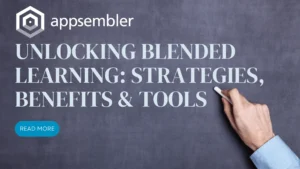Education is not a nice to have when it comes to the developer experience; it’s essential. With that in mind, Appsembler and ContentLab, specialists in technical content creation, recently co-hosted a webinar entitled Developer Education in the Front Lines.
The aim was to give developer marketers, developer advocates, and product marketers an inside look into what it takes to conceptualize and build a developer education experience.
During the webinar, Appsembler CEO Nate Aune and Ryan Peden, Content Expert and Author at ContentLab, shared their thoughts and expertise on the topic of developer education and explained what companies have done to build scalable developer education experiences.
If you missed it, or if you attended it but need a recap, we’ve put together the key takeaways from the webinar.
The Reasons Behind Developer Population Growth
We’ve spoken before about the growth of the developer population — the figure is expected to reach 45 million worldwide by 2030 — but why is this happening? Nate Aune, CEO of Appsembler, discussed a trend he called “accidental technologists,” who are developers who didn’t go into a tech career on purpose, but evolved into developers as their job demanded that they learn tech skills. Nate noted that becoming a developer has become more accessible, leading to a more diverse selection of backgrounds.
Ryan added that broader demographics are also driving this change, as a younger generation enters the workforce with different skills and learning preferences. This younger generation is better equipped and more comfortable with technology, so the transition (or decision) to pursue software development as a profession is easier.
The Growing Influence of Developers in Software Purchasing Decisions
Ryan agreed that developers play a significant role in the software purchasing process, either as the final decision maker or as a kingmaker. Ryan highlighted research that says 1/3rd of sales opportunities are lost because of developer veto.
Prioritizing Developer Education is Key
Nate and Ryan agreed that MongoDB, Stripe, and Twilio have all been successful because they invested in developer education and are doing everything possible to make the developer successful.
Ryan highlighted Stripe in particular as creating an outstanding developer experience with great documentation and tutorials that showcased their product.
Nate added that people who weren’t even using Stripe to build projects were talking about Stripe just because the company nailed their developer documentation. Stripe figured out how to win the hearts and minds of developers by creating great developer tools, sandboxes, and documentation.
Target the Right Audience Through Buyer Persona and Audience Segmentation
According to Ryan, one of the common pitfalls companies encounter when launching or scaling developer education programs is that they haven’t created developer personas or segmented their audience.
Ryan noted that you need to know who you’re trying to reach and what they do and don’t care about. Personas are the best tool to make sure everyone’s on the same page. Having those personas in place makes the beginning of the content curation and developer education process much easier if you have to get buy-in from other people in your company or if you work with an agency like ContentLab,
If you haven’t already created personas, Ryan noted that it’s much harder to visualize and target the right developers with all types of content, from blog posts to tutorials to courses. You don’t know if you’re targeting startups, new and self-taught developers, or veteran developers who have been coding since they were five. Understanding all of these personas is a big part of determining the success of whatever developer-focused content you are creating.
Harnessing Data Improves the Learning Experience
According to Nate, you can collect a lot of granular data when a developer is taking a product course, and the first person to benefit from this is the developer. Developers get real-time feedback as they go through the content, including knowledge checks and quizzes. They’re validating their understanding of the product in an interactive way that reading a blog post can’t. They can also see the clear progression towards the end of the course, helping to nudge them forward and keeping them motivated to learn more about your product.
Nate noted that this data is also important for the course author and the developer marketing team because they can now get information about how developers are performing in their product courses. They can see where developers are getting stuck and where they are dropping off. This helps them to create better courses and improve the developer’s learning experience.
Nate talked about how Appsembler customer Redis – a real-time data platform – runs courses every few weeks and does multiple course runs. They can test and iterate and get feedback from their developers, which means that after every course run, they have the opportunity to improve the course. Redis has been running these courses for years, and have collected a ton of feedback. They also realized that they don’t need to create a perfect course the first time, but it’s important to start collecting feedback from developers as soon as possible.
Another of the significant differences with creating course data is that you know who the developer is. If you’re using Google Analytics to track blog and tutorial views, then the user is anonymous. With a course, you can identify the developer (because they have to register for the course), see their job role and what company they work at, and whether others within their company are also learning about your product. A cluster of developers from the same company learning about your product represents an opportunity for your technical marketing team to launch a highly-personalized campaign aimed at converting these learners into paid users.
This helps with buying intent, understanding where opportunities lie, and whether you need to provide extra support in certain areas or to specific users to guide them further along their learning path.
Developer Education Boosts the Bottom Line
If you’re going to spend money on developer education, it needs to show a return on investment. And it does.
Nate talked about the approach Redis takes to developer education ROI. The company considers anyone who completes a course on Redis University as an MQL. The value of someone who has completed a course on your product, versus someone who downloaded an e-book or white paper, is incomparable.
Ryan added that intent is key. He said that the kind of intent that you get from someone who has worked through your course means that you should be including their course enrollment and course activities in your lead scoring.
Building Awareness is a Priority
We ran a poll during the webinar that asked participants, “How do you measure the success of your developer marketing and developer education programs?” Product awareness topped the poll followed by adoption and other metrics such as reducing customer acquisition costs and decreasing churn.
Nate wasn’t surprised that awareness came top as companies need to prioritize making developers aware of their product. He commented that it’s a noisy space and a lot of products are competing for developers’ attention. According to Nate, developer education is a way to stand above the crowd – it differentiates your developer experience and gets the attention of developers. If you create great educational content for developers, that might make the difference between that developer recommending your product over a competitor.
Hands-on Labs Remove Product Friction
During the webinar, Nate talked about how Appsembler has seen hands-on labs make a huge difference to the developer experience. Hands-on labs remove the friction for the developer to get started with a product versus having to download, install, and configure it, which can be a stumbling block, especially when it comes to the younger generation.
Newer developers often don’t have experience setting up virtual machines and are used to interactive browser-based experiences. Developers have come to expect that kind of experience.
Automate Course Building to Save Time and Effort
According to Nate, if you tried to build a course platform from scratch, it’d probably take you six months to a year, and it’s not the best use of your team’s time. That’s why investing in a scalable authoring and delivery platform for courses — such as Appsembler Tahoe — helps you go to market faster.
Using this kind of platform, you can create assessments, quizzes, and certificates out of the box rather than having to build and maintain them yourself. It saves you time and effort, which you can redeploy back into improving your developer education program.



